![]()
![]()
![]()
Use LEFT and RIGHT arrow keys to navigate between flashcards;
Use UP and DOWN arrow keys to flip the card;
H to show hint;
A reads text to speech;
59 Cards in this Set
- Front
- Back
|
Atmospheric Composition, greenhouse gases |
Nitrogen accounts for 78% of the atmosphere, oxygen 21% and argon 0.9%. Gases like carbon dioxide, nitrous oxides, methane, and ozone are trace gases that account for about a tenth of one percent of the atmosphere Greenhouse gases: a gas that contributes to the greenhouse effect by absorbing infrared radiation. The primary greenhouse gases in Earth's atmosphere are water vapor, carbon dioxide, methane, nitrous oxide, and ozone |
|
|
Global energy balance |
The global energy balance is the balance between incoming energy from the Sun and outgoing heat from the Earth |
|
|
Profiles of General Circulation |
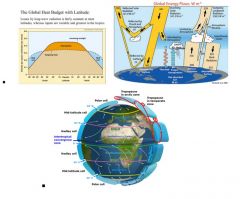
|
|
|
Flux and flux convergence |
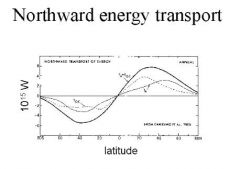
regions of positive slope is divergence, regions of negative slope is convergence |
|
|
Solid Angle |
a three-dimensional analog of an angle, such as that subtended by a cone or formed by planes meeting at a point. It is measured in steradians. |
|
|
Zenith angle |
angle from normal |
|
|
Blackbody radiation |
"Blackbody radiation" or "cavity radiation" refers to an object or system which absorbs all radiation incident upon it and re-radiates energy which is characteristic of this radiating system only, not dependent upon the type of radiation which is incident upon it. The radiated energy can be considered to be produced by standing wave or resonant modes of the cavity which is radiating.The amount of blackbody radiation at a given wavelength is defined by Planck’s Law: |
|
|
Planck's Law |

|
|
|
Stefan-Boltzmann Equation: |

|
|
|
Greenhouse effect: Model 1 |
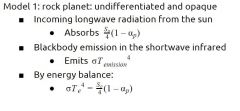
Solving for T in this equation leads to T = 255K but this is not what we see, so the blackbody overall emission temperature of the planet cannot be equal to the surface temperature. Therefore we NEED an atmosphere |
|
|
Greenhouse effect: Model 2 |

|
|
|
Greenhouse effect: Model 3 |
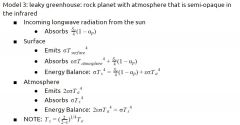
|
|
|
Greenhouse effect: General Model |

|
|
|
Kirchoff's law |

Fraction of absorbed radiation to the fraction of emitted radiation related by monochromatic emissivity = 1-the monochromatic albedo (fraction of reflected radiation by a surface) = absorptivity Wavelength dependent emissivity and absorptivity: it makes sense that the absorbed = emitted = what is not reflected, but the fact that this occurs at each wavelength is significant |
|
|
buoyancy and buoyancy frequency |

|
|
|
Criteria for static stability and instability |
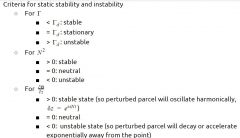
|
|
|
Mixing ratio |
w = mass of vapor/mass of dry air |
|
|
Specific humidity |
q = mass of vapor/(mass of vapor+mass of dry air) |
|
|
Vapor pressure |
e = number of vapor particles/total number of particles * total pressure |
|
|
Saturation vapor pressure |

|
|
|
relative humidity |
RH = vapor pressure/saturation vapor pressure |
|
|
Saturation humidity |
when relative humidity is 100% |
|
|
Skew T plots and stability determination |
|
|
|
Moist Adiabatic Lapse rate |

(moist adiabatic lapse rate = dry adiabatic lapse rate times a temperature and indirectly pressure dependent constant)At low temperatures, the moist adiabatic lapse rate approaches the dry lapse rate (roughly 9.8 C/km) |
|
|
Potential Temperature |

CONSERVED the temperature an unsaturated parcel would have if lowered (or raised) to a level of 1000 mb (100 kPa). The potential temperature is conserved, or remains the same, for a parcel of air that is unsaturated and remains unsaturated as it rises and sinks. |
|
|
Equivalent Potential Temperature |

CONSERVED the temperature a parcel of air would reach if all the water vapor in the parcel were to condense, releasing its latent heat, and the parcel was brought adiabatically to a standard reference pressure, usually 1000 hPa |
|
|
Dry Static Energy |
CONSERVED The dry static energy is a thermodynamic variable that describes the state of an air parcel, and is similar to the equivalent potential temperature (Heat energy + potential energy) S = (C_p)*T + gz |
|
|
Moist Static Energy |
CONSERVED The moist static energy is a thermodynamic variable that describes the state of an air parcel, and is similar to the equivalent potential temperature (Heat energy + potential energy + latent heat from water) S = (C_p)*T + gz+(L_v)*q |
|
|
CAPE: Convective Available Potential Energy |

Defined as the integral from the LFC to the LNB of Force/density (=Buoyancy) with respect to height (the left side is easier to work with because Skew T diagrams have ln p scales) the amount of energy a parcel of air would have if lifted a certain distance vertically through the atmosphere. CAPE is effectively the positive buoyancy of an air parcel and is an indicator of atmospheric instability, which makes it very valuable in predicting severe weather |
|
|
CIN: Convective Inhibition |
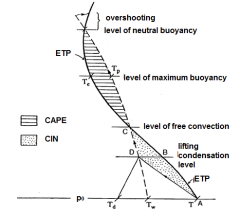
CIN is the amount of energy required to overcome the negatively buoyant energy the environment exerts on an air parcel. In most cases, when CIN exists, it covers a layer from the ground to the level of free convection (LFC). |
|
|
LCL: Lifted Condensation Level |
The lifted condensation level or lifting condensation level (LCL) is formally defined as the height at which the relative humidity (RH) of an air parcel will reach 100% when it is cooled by dry adiabatic lifting.The point in the Skew-T diagram where the lifting curve switches from a dry adiabat to a moist adiabat |
|
|
LFC: Level of Free Convection |
The level of free convection (LFC) is the altitude in the atmosphere where the temperature of the environment decreases faster than the moist adiabatic lapse rate of a saturated air parcel at the same level.The visual lower bound point for the CAPE |
|
|
LNB: Level of Natural Buoyancy |
The level of neutral buoyancy is the the height at which a rising parcel of air is at the same temperature as its environment.The visual upper bound point for the CAPE |
|
|
Ekman Flow |
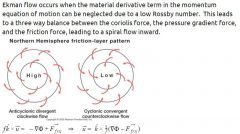
|
|
|
Coriolis and Centrifugal Forces |
Coriolis force per mass: Fcor= -2(Omega) x v where omega is the rotation rate of the reference frame and v is the speed relative to the rotating frame. Centrifugal force per mass: Fcen=Omega x (Omega x r) where r is the position of the particle relative to the axis of rotation for the reference frame |
|
|
How an atmosphere subject to a meridional heating gradient adjusts to balanced flow |
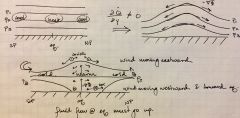
Heating at the equator will cause the geopotential layers to expand ((rho)RT=P, increased T means that must decrease to maintain isobars, thus air “expands”). This expansion at the equator causes a “mound” of fluid at the equator to build up and subsequently slump down to the poles due to gravity, thereby increasing the surface pressure at the poles. Due to this heating, horizontal pressure gradients exist at any point due to the sloping isobars. This incites horizontal motion due to the coriolis force and causes upward motion due to the friction force and resulting Ekman flow around the warm center at the equator. This flow continues to push warm air up and subsequently eastward and towards the poles as it slumps again |
|
|
Core mechanism of extratropical baroclinic instability |
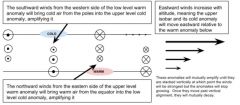
Small anomalies can amplify and anomalies with larger penetration depths are more unstable: dr/H=N/f. The anomaly growth feeds off the meridional temperature gradient of the basic state: wave growth reduces dT/dy, this is the dominant mechanism of meridional energy transport in the mid latitudes. Anomalies are advected by the basic state wind (du/dz>0) so the upper level anomalies drift eastward relative to the low level anomalies, eventual amplification, followed by vertical stacking (which maximizes wind speed) which halts growth. There is vertical motion: dynamics are nearly adiabatic. The motion follows the isentropes which tilt upward away from the equator (peak ascent occurs to the east of the anomaly which is why there is generally precipitation to the east of a temperature anomaly). East coasts of continents foster instabilities |
|
|
Why potential energy can be higher in rotating than in nonrotating fluid |
**GUESS**: movement away from a mound (i.e. poleward movement) is associated with a change in rotation radius, so there should be an increase in kinetic energy due to linear velocity as the fluid parcel moves poleward. |
|
|
Pressure coordinates |

|
|
|
Hadley circulation and ITCZ, how they arise from planetary ageostrophic flow |
Air pushed up at the equator, only goes from +/- 30 degrees, if it extended further than that, due to conservation of angular momentum, wind speeds would reach up to and beyond the sonic barrier. Ageostrophic surface winds occur due to ekman flow due to friction at the surface of the earth, this redirects the winds from high to low pressure and spurs convergence at the ITCZ which, due to mass continuity, must then undergo a rising motion giving rise to the Hadley cell. |
|
|
The material derivative |

|
|
|
Geostrophic balance |

|
|
|
Thermal wind balance (in pressure coordinates) |

|
|
|
Mass continuity in pressure coordinates |

|
|
|
Rossby number |
R = U/(fL) where U is the wind speed, f is the coriolis coefficient, and L is the length scale of the phenomenon. A small Rossby number signifies a system which is strongly affected by Coriolis forces, and a large Rossby number signifies a system in which inertial and centrifugal forces dominate. For example, in tornadoes, the Rossby number is large (≈ 10^3), in low-pressure systems it is low (≈ 0.1 – 1) and in oceanic systems it is of the order of unity, but depending on the phenomena can range over several orders of magnitude (≈ 10^(−2) – 10^2). As a result, in tornadoes the Coriolis force is negligible, and balance is between pressure and centrifugal forces (called cyclostrophic balance). Cyclostrophic balance also commonly occurs in the inner core of a tropical cyclone. In low-pressure systems, centrifugal force is negligible and balance is between Coriolis and pressure forces (called geostrophic balance). In the oceans all three forces are comparable (called cyclogeostrophic balance). For a figure showing spatial and temporal scales of motions in the atmosphere and oceans |
|
|
Rossby deformation radius and penetration depth |

|
|
|
Hydrostatic balance |
Fluid parcel in question is at rest because external forces such as gravity are balanced by a pressure gradient force |
|
|
Hydrostatic Balance, Pressure (z), and Scale Height |

|
|
|
Ideal Gas Law |
pV = NRT or p = (rho)RT where R = 8.31 J/(mol K) |
|
|
Optical Depth |

|
|
|
Differential Form of Schwarzschild’s equation |
![Radiance along a particular direction either increases or decreases with distance, depending on whether I(s) is less than or greater than B[T(s)], where T(s) is the temperature at point s
Extinction + emission = total intensity at each wavelength](https://images.cram.com/images/upload-flashcards/39/94/26/20399426_m.jpg)
Radiance along a particular direction either increases or decreases with distance, depending on whether I(s) is less than or greater than B[T(s)], where T(s) is the temperature at point s Extinction + emission = total intensity at each wavelength |
|
|
First law of thermodynamics for an ideal gas (with and without hydrostatic balance) |

|
|
|
Enthalpy |
dh = (C_p)dT |
|
|
Dry Adiabatic Lapse Rate |
Adiabatic ⇒ dQ = 0, therefore, assuming hydrostatic balance: (C_p)dT=-gdz so -dT/dz= lapse rate for the dry adiabat = g/(C_p) which roughly equals 9.8 K/km |
|
|
Equations of Motion for a rotating frame |

|
|
|
Equation for thermal wind balance (pressure coordinates) |

|
|
|
Equations for the coriolis and centrifugal forces |

|
|
|
Rossby Number |

|
|
|
Rossby Deformation Radius |

|

